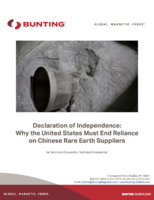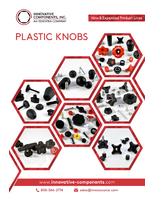Thermacore Delivers Constant Conductance Heat Pipes and k-Core® Structural Components to NASA
Lancaster, PA - Thermacore (www.thermacore.com), a leading provider of advanced thermal solutions, announced today that it recently delivered Constant Conductance Heat Pipes (CCHPs) to NASA in support of the agency's Global Precipitation Measurement (GPM) mission, as well as high thermally conductive k-Core® structural components for the agency's Thermal Infrared Sensor (TIRS) program supporting the Landsat Data Continuity Mission (LDCM).
Thermacore designed and fabricated the CCHPs to meet NASA's rigorous thermal performance, quality and reliability standards. CCHPs from Thermacore-ideal for satellite thermal management applications, where gravity is not a factor-provide effective heat transfer (hundreds of watts) over long distances (up to three meters or more). The high-reliability, maintenance-free heat pipes, are very efficient in returning the working fluid condensate to the evaporator.
The high-conductance k-Core® based structural components used on the LDCM TIRS instrument include a mount for a cryocooler, a thermal doubler in a radiator, and a thermally conductive link connecting a telescope enclosure to a radiator. With up to six times the conductance of solid aluminum designs and up to 20 percent lower mass, these k-Core® components were able to resolve critical thermal management challenges on this platform. Thermacore's passive k-Core® material is a patented system that encapsulates Annealed Pyrolytic Graphite (APG) within a structural shell. Numerous shell materials have been qualified; aluminum alloy is being used in the TIRS application.
"We are pleased to be contributing to NASA's important GPM and LDCM missions, and look forward to continuing to collaborate with the agency on future projects," said Nelson Gernert, Thermacore Vice President, Engineering and Technology. "Thermacore's CCHPs provide reliable performance over a -30°C to 50°C operating range, making it a perfect solution for the long duration mission of the GPM satellite. The k-Core® material system was the only solution, within the mass budget, that fulfilled the LDCM's dual requirements of high thermal conductance and structural stiffness for both the cryocooler mount and the telescope enclosure to radiator conductive link."
NASA's GPM program seeks to measure the distribution, amount, rates and the associated heat release or precipitation throughout the world. Accurate global precipitation measurements will benefit scientists who study the weather and climate, and will help those in the hydro-meteorological and applications communities. Precipitation is difficult to measure because precipitation systems tend to be somewhat random in character and also evolve rapidly. Furthermore, ground-based precipitation measurements are difficult to obtain over regional and global scales because most of the world is covered by water and many countries are not equipped with precision rain measuring sensors (i.e., rain gauges and/or radars). The most practical way to obtain useful regional and global scale precipitation measurements is from the vantage point of a space-based remote sensing instrument like a satellite.
NASA's TIRS program is one of two programs that develop scientific instruments for the Landsat Data Continuity Mission (LDCM) satellite. The TIRS instrument is a two-channel thermal imager that was developed to provide radiometrically calibrated, geo-Iocated thermal image data of the earth's surface. LDCM is a collaboration between NASA and the U.S. Geological Survey that will provide measurements of the Earth's terrestrial and Polar Regions in the visible, near-infrared, short wave infrared, and thermal infrared spectrums. In addition to widespread use for land development and monitoring on regional to local scales, the program will support disaster response and evaluations, and water use monitoring. LDCM measurements directly benefits NASA research in the areas climate, carbon cycle, ecosystems, water cycle, biogeochemistry and earth surface/interior, as well as support people and businesses in the agriculture, geology, forestry, regional planning, education, mapping, and global change industries.
About Thermacore:
Founded in 1970, Thermacore specializes in the custom design, development, and manufacturing of highly engineered thermal management systems and components for a variety of OEM applications across a diversified set of global markets that includes Military/Aerospace, Computer, Communication, Energy Conversion, Medical, Transportation, Test Equipment, and Automotive. With over 40 years of experience in the design, development, and manufacturing of advanced solid conduction assemblies, passive two-phase systems, and active pumped systems, Thermacore brings unparalleled engineering design expertise and thermal solution performance, quality, and reliability to these markets. Thermacore employs more than 185 employees at 5 facilities located in the United States (Lancaster, Pennsylvania; Langhorne, Pennsylvania, Jefferson Hills, Pennsylvania, and Ronkonkoma Long Island, New York) and the United Kingdom (Ashington, Northumberland). Thermacore facilities are certified to AS 9100 Rev B., ISO 9001:2008 and ISO 14001:2004 quality standards. For information about Thermacore, visit www.thermacore.com.
Media Contact:
Gregg J. Baldassarre
Vice President, Sales and Marketing
E-mail: g.j.baldassarre@thermacore.com
Related Links:
www.thermacore.com
http://www.thermacore.com/products/axially-grooved-ammonia-heat-pipe.aspx
http://www.thermacore.com/products/kcore.aspx




